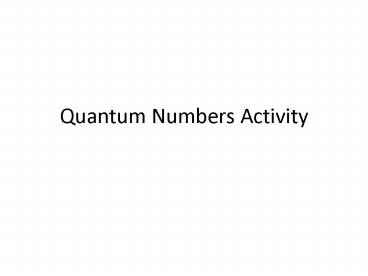Quantum Numbers Activity - PowerPoint PPT Presentation
1 / 24
Title:
Quantum Numbers Activity
Description:
Quantum Numbers Activity Quantum Numbers Quantum numbers tell us properties of the atomic orbitals, and electrons, in an atom. Like giving each electron its own ... – PowerPoint PPT presentation
Number of Views:255
Avg rating:3.0/5.0
Title: Quantum Numbers Activity
1
Quantum Numbers Activity
2
Quantum Numbers
- Quantum numbers tell us properties of the atomic
orbitals, and electrons, in an atom. - Like giving each electron its own addres
- An orbital is a 3-D region of an atom where there
is a high probability of finding electrons (NOT
an actual ring NOT like the planetary orbitals)
3
Principal Quantum Number
Angular Momentum Quantum Number
Magnetic Quantum Number
Spin Quantum Number
4
Textbook
- You will need a textbook to look up information
about the quantum numbers. Pg. 101.
5
Know for each Quantum
- Definition
- Symbol
- The allowed values
- An example
- A visual representation of the quantum number
6
Review Quantum Numbers as a Class
- Discussion of the 4 types of quantum numbers and
there properties
7
Quantum Number Review Notes
8
Quantum Numbers
- Used to describe various properties of the
orbitals - Each electron is assigned a set of four quantum
numbers which, in order, are n, l, ml , and ms - Like giving each electron its own address
9
Principle quantum number
- Definition indicates the main energy level
occupied by the electron - Symbol n
- Values (written as integers) 1,2,3,4,5,6,7
10
Angular Momentum Quantum Numbers
- Definition indicates the shape of the orbital
- Symbol l
- Values
- 0 s
- 1 p
- 2 d
- 3 f
- For a specific energy level, the number of
orbital shapes available is equal to n -1
11
Magnetic Quantum Numbers
- Definition represents the orientation of an
orbital around the nucleus - Symbol ml
- Values for a p-orbital -1, 0 , 1
12
Spin Quantum Numbers
- Definition represents the spin states of
electrons in an orbital - Symbol ms
- Values 1/2, - ½
13
(No Transcript)
14
Can an e- be described by the following set of
quantum numbers?
- n2, l1, ml -1
- All quantum numbers are allowed values
15
Can an e- be described by the following set of
quantum numbers?
- n1, l1, ml 1
- Not possible.
- The value of l must be less than the value
- of n.
16
Can an e- be described by the following set of
quantum numbers?
- n7, l3, ml 3
- All the quantum numbers are allowed
- values.
17
Can an e- be described by the following set of
quantum numbers?
- n3, l1, ml-3
- Not possible.
- The value of ml must be in the range
- -l to l
18
Replace the ? Mark with an appropriate quantum
number.
- n3, l1, ml?
- n4, l?, ml-2
- n?, l3, ml?
19
Can an e- be described by the following set of
quantum numbers?
- n2, l1, ml-2
- n3, l2, ml2
- n4, l3, ml3
- n5, l2, ml3
20
Writing Quantum Numbers
- You can identify the quantum numbers for any
electron in an element - Start by writing out the the electron
configuration and orbital diagram for the element - Locate the electron in the orbital diagram that
you are solving the quantum number for - Determine the 4 quantum numbers
21
Hydrogens electron
- Write electron configuration
- Draw orbital diagram
- n 1
- l 0
- ml 0
- ms 1/2
22
Heliums second electron
- Write electron configuration
- Draw orbital diagram
- n 1
- l 0
- ml 0
- ms -1/2
23
Lithiums third electron
- Write electron configuration
- Draw orbital diagram
- n 2
- l 0
- ml 0
- ms 1/2
24
Flourines 6th electron
- Write electron configuration
- Draw orbital diagram
- n 2
- l 1
- ml 0
- ms 1/2































